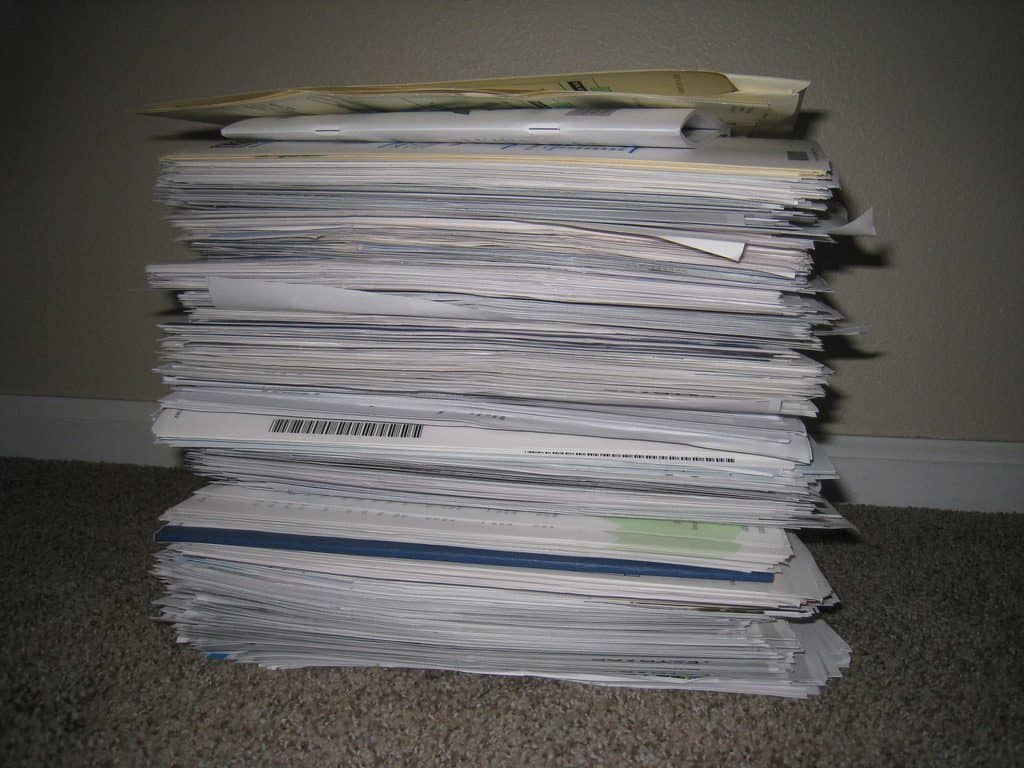One of the most basic parts of personal finance is managing your financial accounts. Your bank accounts, investment accounts, retirement accounts, and credit and debt accounts come together to make up your financial picture.
Taking an account inventory isn’t exciting or glamorous, but it can be the most telling place to start when trying to understand or fix your finances.
Gather Paper Statements from Last 90 Days
The first thing to do when preparing for an account inventory is to gather your paper financial statements from the last 90 days. Why 90 days? Some banks and investment institutions only send statements quarterly.
In general I suggest everyone moves away from using paper statements and move to all online statements. Electronic statements help prevent identity theft from the mailbox, help you reduce clutter, and even do a little for the environment.
If you do prefer paper statements, you don’t have to keep them all forever. I’ve done a detailed post on how long to keep bank statements and other financial documents. When it is time to get rid of them, remember to always use a shredder.
Gather Electronic Statements from Last 90 Days
Next, go through and do the same with your online statements. You can do this on the computer or by printing the most recent statement for each account just to stay organized.
I get electronic statements for the majority of my financial accounts. I keep track of them using Empower and Manilla. But more about that later. For now, just grab the most recent statement from each account to help with this project.
Make a List of Bank Accounts
The core of your financial system is your checking account. All money that goes in and out should go through your checking at some point. Whether it is a paycheck on direct deposit or a credit card payment, almost everything goes through your bank accounts (other than automated investments).
Not including business accounts, you should only ever have one primary checking account. If you have multiple, I highly encourage you to simplify. I have one online checking account, one online savings account, and one account at a credit union so I can deposit cash locally. That’s it.
Some people keep a dollar or two in old account just to keep them open, and that is a silly idea. There is no value in keeping bank accounts that you don’t use. Try to clean house and make it simple.
Make a List of Credit Cards and Loans from Credit Sesame
The easiest way to make a list of credit cards in your name is to look at your credit report. You should check your credit report regularly anyway, but it has an extra use when trying to list out your credit cards.
You can get a credit report 100% free from Credit Sesame, a site I visit for my own free report once every month.
When you make a list of credit cards, you should list a memorable name for the card, balance, credit limit, interest rate, and annual fee. If you are paying an annual fee that doesn’t give you a value worth more than the fee, you should cancel it. Otherwise, you should generally keep your credit accounts open.
Make a List of Investment and Retirement Accounts
Finally, make a list of your retirement accounts and investment accounts. Most of us have only a few of these, so it is usually easy to track them in total. Investment accounts are your long term, wealth building accounts, so they are important to watch for fees and costs. I used Empower to save over $300 per year in fees on my investment accounts earlier this year.
If you have multiple old 401(k) or 403(b) accounts from a prior employer, make sure to consolidate them with a rollover into either a rollover IRA or one 401(k) with your current employer. I suggest a rollover IRA, as it will likely involve lower fees and give your more investment options.
Simplify and Close What You Can
As you likely noticed, I am a big fan of having fewer accounts to track and monitor. If you can, always simplify and make life easier on yourself.
How do you keep your accounts in order? Please share your tips in the comments.
Image by Dvortygirl / flickr


Closing unused accounts is a good idea, even if you aren’t being charged any account keeping fees – it means less paperwork, simpler tax returns and you avoid them changing the rules and charging you in future!
I used to keep old accounts open, but after I got a letter telling me about a new monthly fee at US Bank, I closed down everything I wasn’t using to make sure I didn’t pay any fees to any banks.